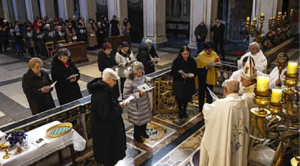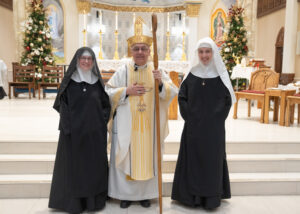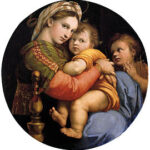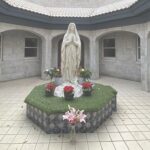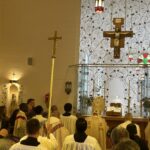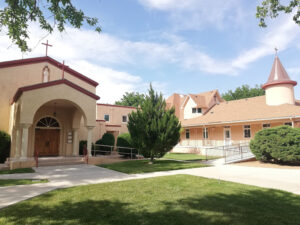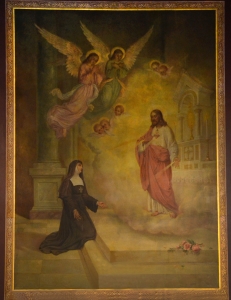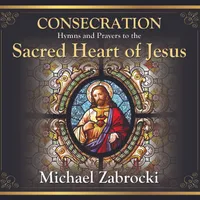 Interview with Fr. Ambrose Criste, O.Praem., of St. Michael’s Abbey in Silverado, California
Interview with Fr. Ambrose Criste, O.Praem., of St. Michael’s Abbey in Silverado, California
You are a Norbertine Canon Regular at St. Michael’s Abbey in California. Would you briefly tell us about yourself and the Norbertine community of which you are a part?
IRL Affiliates and readers of Religious Life Magazine will know St. Michael’s Abbey as the home of Fr. Thomas Nelson, who has been the National Director of the IRL for several decades. Our abbey in Southern California began with seven Hungarian Norbertines who were refugees forced out of their monastery (also called St. Michael’s Abbey and founded in 1180) under the Communist persecution of the 1950’s.
From those seven Hungarian refugees, St. Michael’s Abbey has grown to nearly 100 members – roughly 60 priests and solemnly professed brothers and 40 novices and juniors preparing for religious profession and priestly ordination. We live the rich liturgical life of canons regular, and we undertake a number of apostolic works, from the administration of parishes and schools, to directing retreats, various chaplaincies, and even evangelization and teaching on social media and our own Abbot’s Circle virtual monastery.
I joined the abbey in the year 2000 after completing my undergraduate degree and some graduate school. I was ordained a priest in 2008, and then served as our abbey’s novice master, master of juniors, and vocations director for nearly 14 years. I have worked closely with our development and finance team over many years to serve our mission with adequate resources. More recently, I am working on a new project our canonry has undertaken called the Evermode Institute, a program of catechetical formation for Catholic school teachers and parish catechists to be used nationwide.
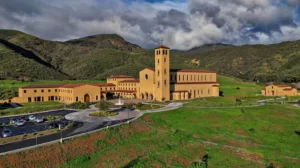
Your community dedicated the newly built St. Michael’s Abbey just three short years ago, after securing more than $120 million in financial commitments for its construction. Could you share with us how your community went about accomplishing such an ambitious project and what it taught you about fundraising and stewardship?
Through the firm and faithful witness of the founding priests and those aspiring to live the Norbertine ideal, a surge of vocations in the late 1990s and early 2000s left St. Michael’s Abbey in great need of more space. We launched a campaign to build a new abbey that was projected to cost north of $120M.
We struggled with fits and starts (and multiple consultants) over the next decade. By 2016 the campaign had stalled by many accounts, and we found that we had no real path to achieve our goal. That prompted us to stop listening to outside consultants and to try to do things differently.
We had originally thought, “We are priests and religious– what do we know about finances? Let’s bring in experts who know how to do this.” But the reality was that that didn’t work. The experts used a templated approach that left aside many of our gifts as consecrated religious, and rendered our fundraising transactional and ultimately unsatisfying.
It wasn’t until we integrated our fundraising effort into our way of life as religious that we found meaningful success. We made it a spiritual and pastoral endeavor rather than a transactional one, and the Lord blessed it. By early 2018, we hit our $120M goal and ultimately raised in the neighborhood of $150M, paid off all of our bank debt, and quadrupled general donations for operations.
It was an authentically Catholic approach to generating and managing resources that allowed us to complete the project our Lord had entrusted to us. It is not a novel concept– it’s a model that dates back to the time and teaching of Ss. Peter and Paul.
You just mentioned that an authentically Catholic approach to managing resources is not novel– but perhaps it is often neglected? What are the challenges you see as religious communities and Catholic institutions seek to manage their finances properly?
Very interesting question. So, on the heels of our campaign, we found ourselves providing a great deal of counsel to other religious communities. We tried to promote the strategy that had worked for us, by providing a tailored and spiritual approach to fundraising, and in this way, ultimately helped raise hundreds of millions of dollars for worthy Catholic projects. While working closely with Catholic leaders, they began to draw us into broader financial conversations and more freely expressed their concerns, particularly as relates to investing.
We quickly realized that of the many financial challenges they presented, the morality of investments was a tacit, yet deadly moral crisis. We have taken a keen interest in understanding this issue in order to help think through ways that religious communities and Catholic institutions can generate meaningful returns from their investment portfolios while not falling into the real moral pitfalls that have recently flown under the radar.
You say there is a crisis in the morality of investing. Can you speak into that a bit more?
Since the Dobbs ruling in 2022, many companies have become abortion activists– and this is just one of the ways that these companies are not measuring up to the USCCB Socially Responsible Investment guidelines.
As a result of this change, many Catholic religious communities were seamlessly transitioned into implicitly cooperating with evil. Further, the Catholic screens then implemented to protect Catholic institutions from falling prey to this cooperation proved to be inconsistent, and in too many cases inadequate.
As Catholics, we are called to be excellent in all we do. For investing, that means generating returns to serve our mission without compromising our morals in the process. As Norbertines, we think there is an opportunity to generate these returns morally, and we are leaning into this opportunity by researching the best ways to do this, especially through dialogue with our fellow religious.
How can our readers, especially orders, congregations, and communities like yours, learn more about the abbey’s work and be part of a larger conversation about raising and managing resources in an authentically Catholic way, and in particular, investing with a clear conscience?
We are taking a great interest in the area of authentically Catholic investing because we feel a call to be good stewards of the resources God has entrusted to us— but as you pointed out, investing is part of a much larger topic. We know these resources are only a means to an end, which is to serve Christ and His Church fully in the way He intended, and that is our motivating drive.
We have recently launched an unprecedented study that will serve to support religious who are trying to to be faithful stewards of what God has entrusted to them.
If any religious community should want to share their experience and perspective in the survey, they can contact me via email at frambrose@stmichaelsabbey.com. If there are broader questions on the topic of investing or fundraising, we are happy to share our research and thoughts in those areas as well.If you are a religious community interested in participating in a brief online survey conducted by St. Michael’s Abbey about this matter, please contact the Institute on Religious Life (irlstaff@religiouslife.com) for more information.
Like this:
Like Loading...


